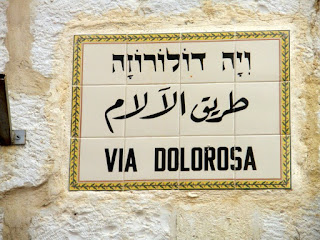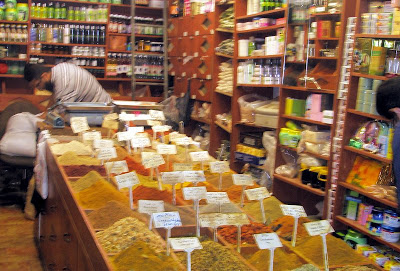 |
| Sheer Desert Cliffs around Qumran |
Saturday saw an early start. We were on the minibus by 7.45 and heading for Qumran, an archaeological site in the West Bank. It is best known as the settlement nearest to the caves in which the Dead Sea Scrolls were hidden, caves in the sheer desert cliffs and beneath, in the marl terrace.
 |
| The Scrolls were preserved in containers like these |
Since the discovery from 1947 to 1956 of nearly 900 scrolls in various conditions, mostly written on parchment, with others on papyrus, and one on copper, extensive excavations of the settlement have been undertaken. Cisterns, Jewish ritual baths, and cemeteries have been found, along with a dining or assembly room and debris from an upper story alleged by some to have been a scriptorium as well as pottery kilns and a tower.
 |
| One of the caves at Qumran |
From Qumran we headed off towards Masada with a diversion through a date plantation.
 |
| In a date plantation |
Masada is a site of ancient palaces and fortifications on top of an isolated rock plateau overlooking the Dead Sea.
 |
| Herod's Palace, Masada |
 |
| Cable car to the top of Masada |
It is best known for the violence that occurred there in the first century CE. After the destruction of the Second Temple in 70 CE, numerous Jewish families fled Jerusalem and settled on the mountaintop, where zealots were already using it as a base for harassing the Romans. In the final accords of the First Jewish-Roman War, the Siege of Masada by troops of the Tenth Legion of the Roman Empire led by Flavius Silva led to the taking of Masada when, after two to three months of siege, the Romans finally breached the wall of the fortress with a battering ram.
 |
| Roman Camp at the base of Masada |
 |
| Synagogue at Masada |
According to Josephus, when Roman troops entered the fortress, they discovered that its 960 inhabitants had set all the buildings but the food storerooms ablaze and committed a mass suicide.
After a lunch stop we moved on toward the Dead Sea with a brief stop at a company which makes cosmetics from chemicals found there. This body of water is the lowest place on earth, being 423 metres below sea level. With 33.7% salinity, it is also one of the world's saltiest bodies of water, and is 8.6 times saltier than the ocean. This makes for a harsh environment in which animals cannot flourish, hence its name. The Dead Sea is 67 kilometres long and 18 kilometres wide at its widest point. It lies in the Jordan Rift Valley, and its main tributary is the Jordan River.
 |
| A bathing beach on the Dead Sea |
The Dead Sea has attracted visitors from around the Mediterranean basin for thousands of years. Biblically, it was a place of refuge for King David. It was one of the world's first health resorts (for Herod the Great), and it has been the supplier of a wide variety of products, from balms for Egyptian mummification to potash for fertilizers. People also use the salt and the minerals from the Dead Sea to create cosmetics and herbal sachets.
We stopped long enough for a swim (or rather a float since the water is too buoyant in which actually swim). Some of our group coated themselves in the mineral mud while others used the pool which is sulphur rich.
 |
| Bathing in the Dead Sea |
 |
| Guess Who? |
 |
| Mudding up in the Dead Sea |
In recent decades, the Dead Sea has been rapidly shrinking because of diversion of incoming water from the Jordan River to the north, reaching a drop rate of 1 m (3 ft) per year. As the water level decreases, the characteristics of the Sea and surrounding region may substantially change.
Then we were homeward bound with a short drive through a nature park to see the native Ibexes. We arrived back at the hotel in the middle of the afternoon.
 |
| Ibexes |























































